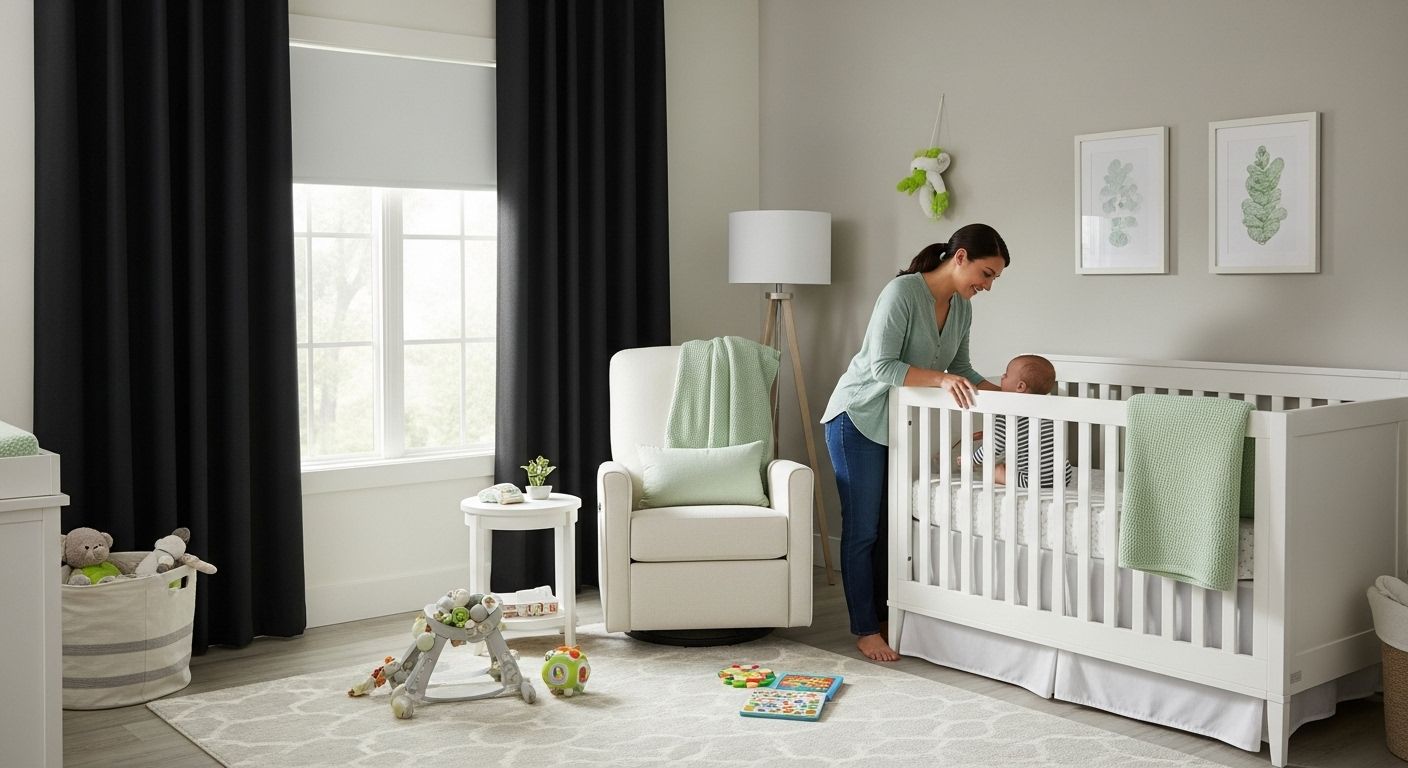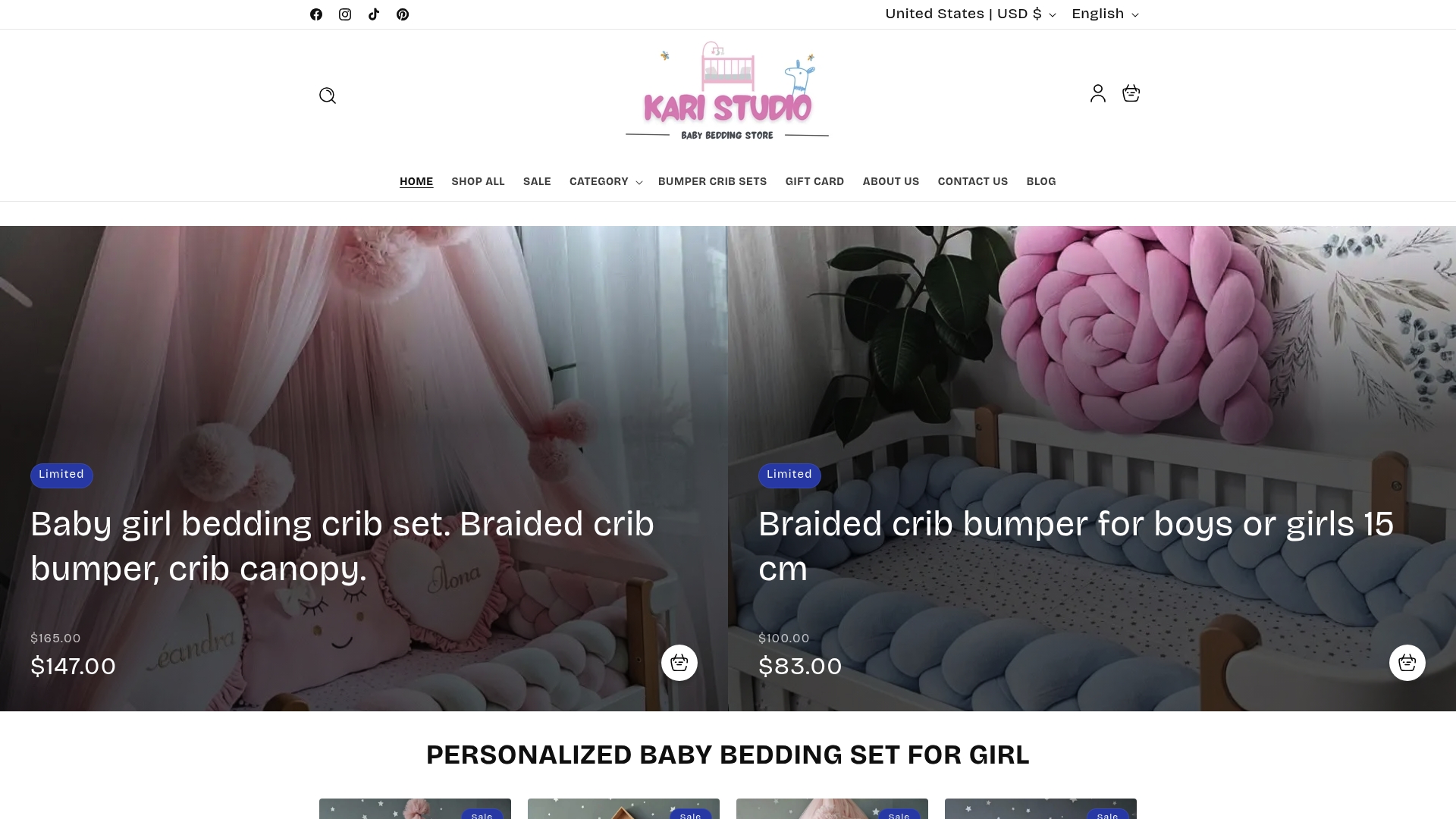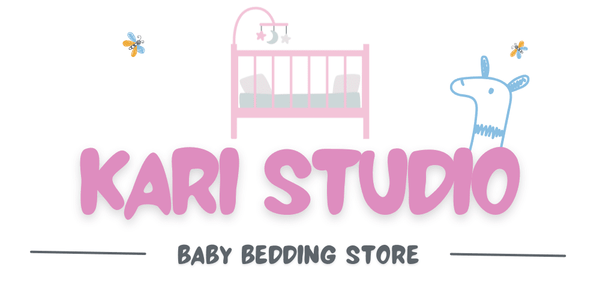
Parents want nothing more than a peaceful night’s sleep for their baby, but even the softest crib and calmest nursery can fall short when daylight sneaks in. Turns out, non-dark sleep environments can cut nighttime sleep for infants by about 30 minutes. That number surprises almost everyone. Most would assume blackout curtains are just about blocking light, yet their effects stretch way beyond darkness to shaping your child’s health and daily rhythms in ways you might not expect.
Table of Contents
- Understand The Benefits Of Blackout Curtains
- Consider Fabric Types For Light Blocking
- Evaluate Curtain Length And Coverage
- Check For Noise Reduction Features
- Explore Color And Design Options
- Look For Easy Installation And Care
- Read Reviews And Compare Brands
Quick Summary
| Takeaway | Explanation |
|---|---|
| Invest in blackout curtains for improved sleep | Blackout curtains significantly enhance an infant’s sleep quality by reducing light exposure and promoting a darker sleep environment. |
| Choose the right fabric for effectiveness | Opt for tightly woven synthetic materials that maximize light blocking and durability for nursery curtains. |
| Ensure proper curtain length and coverage | Curtains should extend beyond the window frame to eliminate light gaps, ensuring a completely dark space for better sleep. |
| Prioritize noise reduction features | Thicker, multi-layered fabrics in blackout curtains help dampen external sounds, promoting uninterrupted rest for infants. |
| Select colors and designs thoughtfully | Use soft, neutral tones to create a calming nursery environment that supports your baby’s sleep and minimizes overstimulation. |
1: Understand the Benefits of Blackout Curtains
Creating the perfect sleep environment for your infant involves more than just a comfortable crib. Blackout curtains have become an essential tool for parents seeking to optimize their baby’s sleep quality and overall well-being. These specialized window treatments do far more than simply block light.
Research from Northwestern University reveals that exposure to moderate ambient lighting during nighttime can negatively impact cardiovascular function and metabolic processes. For infants, whose sleep patterns are still developing, this becomes even more critical.
Blackout curtains offer several key advantages for nursery environments:
- Improved Sleep Quality: Helps babies fall asleep faster and stay asleep longer
- Circadian Rhythm Regulation: Supports natural sleep-wake cycle development
- Temperature Control: Provides additional insulation and helps maintain consistent room temperature
A comprehensive study involving infant sleep patterns demonstrated that non-dark sleep environments can reduce nighttime sleep by approximately 30 minutes. This significant reduction highlights the importance of creating a dark, conducive sleeping space for your infant.
Beyond sleep benefits, blackout curtains also protect your baby’s delicate skin from harsh direct sunlight and help minimize external noise, creating a serene and comfortable nursery environment. By investing in high-quality blackout curtains, you are not just purchasing a window covering but making a strategic choice to support your child’s health and developmental needs.
When selecting blackout curtains, consider factors like material quality, light-blocking efficiency, and ease of installation. These considerations will help you choose curtains that provide maximum benefits for your nursery.
2: Consider Fabric Types for Light Blocking
Selecting the right fabric for nursery blackout curtains is more complex than simply choosing a visually appealing design. Fabric composition plays a crucial role in determining the curtain’s light-blocking effectiveness, durability, and overall performance.
According to Consumer Reports, effective blackout curtains typically feature multiple layers, with a white inner layer of woven polyester that minimizes light penetration. This strategic design ensures maximum light blocking while maintaining an elegant drape.
When evaluating fabric types, parents should consider several key characteristics:
- Density: Tightly woven fabrics provide superior light blocking
- Material Composition: Polyester and microfiber offer excellent light-blocking properties
- Weave Complexity: Multiple-layer fabrics prevent light leakage
Synthetic fabrics like polyester and microfiber often outperform natural materials in nursery settings. These materials offer several advantages beyond light blocking, including:
- Easier maintenance and cleaning
- Enhanced durability
- Resistance to moisture and potential mildew
- Better color retention
Parents should also pay attention to fabric weight and thickness. Heavier fabrics typically provide more comprehensive light blocking and additional thermal insulation, helping maintain a consistent nursery temperature.
While aesthetic considerations matter, prioritizing functional fabric characteristics ensures you create an optimal sleep environment for your infant. Look for curtains that combine technical performance with visual appeal, striking a balance between practical light blocking and nursery design aesthetics.
Remember that not all blackout curtains are created equal. Carefully examine fabric specifications, read customer reviews, and potentially request fabric samples to ensure you select the most effective light-blocking solution for your nursery.
3: Evaluate Curtain Length and Coverage
Ensuring comprehensive light blocking in a nursery demands careful consideration of curtain length and coverage. The right curtain dimensions can transform your baby’s sleep environment, preventing unwanted light infiltration and creating a consistently dark space.
According to NIOSH guidelines, window coverings should extend beyond the window frame to maximize light reduction and minimize potential gaps. This principle becomes critical when designing a sleep-conducive nursery.
When selecting blackout curtains, parents should focus on several key measurement considerations:
- Floor Length: Curtains should nearly touch the floor to prevent light seepage
- Width: Choose curtains 1.5 to 2 times wider than the window for full coverage
- Mounting Height: Install curtain rods 4-6 inches above the window frame
Additional factors to consider for optimal light blocking include:
- Ensuring curtains overlap in the center when closed
- Selecting curtains with built-in side channels or weighted bottoms
- Checking for potential light gaps around window edges
Precise measurements are crucial. Before purchasing, carefully measure your nursery windows, accounting for potential variations in window size and shape. Standard window sizes can differ significantly, and custom-fit curtains might be necessary for irregular or unusually sized windows.
Consider the mounting technique as well. Ceiling-mounted or wider-than-window rod installations can provide additional light-blocking capabilities by creating a more comprehensive light barrier. This approach minimizes side gaps and ensures maximum darkness for your infant’s sleep environment.
Remember that perfect coverage goes beyond simple measurement. Look for curtains with thoughtful design elements like side tracks, magnetic closures, or velcro attachments that help seal potential light entry points. Your goal is to create a consistently dark, tranquil space that supports your baby’s natural sleep cycles.
4: Check for Noise Reduction Features
When designing a nurturing sleep environment for your infant, noise reduction becomes just as crucial as light blocking. The right blackout curtains can serve a dual purpose, creating a serene sanctuary that promotes uninterrupted rest.
According to research in the International Journal of Environmental Research and Public Health, sound-absorbing materials in bedrooms can significantly impact sleep health for infants and children. Thick, strategically designed curtains play a pivotal role in dampening external sounds that might otherwise disturb your baby’s sleep.
Key considerations for noise reduction in nursery curtains include:
- Fabric Density: Thicker, heavier fabrics absorb more sound
- Multiple Layers: Layered curtains provide enhanced sound dampening
- Material Composition: Certain synthetic materials offer better acoustic properties
Parents should look for specific noise reduction features when selecting blackout curtains:
- Curtains with dense, tightly woven fabrics
- Thermal-backed or quilted curtain designs
- Curtains with additional sound-absorbing linings
Acoustic performance varies significantly across different curtain types. While no curtain can completely soundproof a room, choosing the right fabric can reduce noise levels by up to 50%. This reduction can make a substantial difference in maintaining your baby’s sleep cycle, especially in homes near busy streets or with active household environments.
Consider the specific sound challenges in your nursery. Urban environments with street noise, neighboring apartments, or homes near transportation routes will benefit most from noise-reducing curtain technologies. Strategically selected curtains can transform a potentially disruptive environment into a peaceful sleep haven.
Remember that noise reduction is about more than just thickness. The quality of fabric, its weave pattern, and additional sound-absorbing technologies all contribute to creating a quieter, more restful nursery environment for your infant.
5: Explore Color and Design Options
Selecting the right color and design for nursery blackout curtains involves more than aesthetic preferences. Color psychology and visual design play significant roles in creating a soothing environment that supports your infant’s sleep and overall developmental well-being.
According to research on children’s environments, highly stimulating color schemes can potentially distract and overstimulate young children. This insight underscores the importance of choosing calm, neutral, or soft-toned curtains for your nursery.
When exploring color and design options, consider these key principles:
- Neutral Tones: Soft grays, whites, and muted pastels promote relaxation
- Minimalist Patterns: Simple, understated designs reduce visual complexity
- Complementary Room Aesthetics: Select colors that harmonize with existing decor
Design considerations that support optimal sleep environments include:
- Avoiding high-contrast or bold color combinations
- Selecting textures that appear soothing and gentle
- Ensuring curtain design does not create visual distractions
Subtle design elements can transform blackout curtains from mere functional items to integral parts of your nursery’s aesthetic. Consider curtains with gentle texture variations, soft ombré effects, or minimalist geometric patterns that add visual interest without overwhelming the space.
Color selection also impacts perceived room temperature and emotional atmosphere. Cooler tones like soft blues and greens can create a sense of calm, while warm neutrals provide a sense of comfort and security. The goal is to create a visually peaceful environment that supports your baby’s natural sleep rhythms.
Remember that your curtain choice is more than a decorative decision. It is a strategic component of your nursery design that can significantly influence your infant’s sleep quality and overall sensory experience.
6: Look for Easy Installation and Care
Parents juggling multiple responsibilities need nursery solutions that simplify their lives. When selecting blackout curtains, installation ease and maintenance become crucial factors that can significantly reduce daily stress.
According to the U.S. Consumer Product Safety Commission, safety should be the primary consideration when choosing window coverings, especially in nurseries. Cordless options eliminate potential hazards and provide straightforward installation.
Key installation considerations include:
- Rod Compatibility: Ensure curtains work with standard or existing curtain rods
- Mounting Flexibility: Look for versatile hanging options
- Weight Distribution: Select curtains that hang evenly without sagging
For easy maintenance, prioritize curtains with these characteristics:
- Machine washable fabrics
- Wrinkle-resistant materials
- Stain-repellent treatments
Practical features can make a significant difference in your daily routine. Magnetic closures, built-in hooks, or integrated side channels can provide additional light blocking while simplifying installation. Some modern blackout curtains come with innovative design elements that make mounting and adjusting a breeze.
Maintenance should be straightforward. Opt for fabrics that can be machine washed and dried without losing their light-blocking properties or structural integrity. Microfiber and polyester blends often offer the best combination of easy care and durability.
Remember that installation is not a one-time event. Choose curtains that can be easily adjusted or replaced as your nursery evolves. Some parents prefer curtains with reinforced grommets or tab-top designs that allow for simple repositioning and minimal wear on the fabric.
7: Read Reviews and Compare Brands
Navigating the world of blackout curtains requires strategic research and careful brand comparison. Not all curtains are created equal, and understanding the nuanced differences can help you make an informed decision for your nursery.
According to Consumer Reports, comprehensive testing revealed significant variations in light-blocking performance across different brands. Only a select few curtains effectively blocked light consistently across their color ranges.
When comparing brands, focus on these critical evaluation criteria:
- Light Blocking Performance: Measure actual light reduction percentage
- Material Quality: Assess fabric durability and texture
- Customer Feedback: Review experiences from other parents
Key aspects to investigate during your brand comparison include:
- Verified customer reviews detailing real-world performance
- Independent testing results for light blocking capabilities
- Warranty and return policy details
User experiences provide invaluable insights that technical specifications cannot capture. Pay attention to reviews discussing specific scenarios like complete darkness achievement, fabric longevity, and ease of maintenance.
Consider seeking recommendations from parenting forums, professional review sites, and trusted pediatric sleep resources. These platforms often provide nuanced perspectives that go beyond manufacturer marketing claims.
Remember that price does not always correlate with quality. Some mid-range brands offer exceptional performance at a fraction of the cost of premium options. Thoroughly investigate multiple brands, read comprehensive reviews, and potentially request fabric samples before making your final selection.
Below is a comprehensive table summarizing the key considerations, benefits, and steps for choosing the best blackout curtains for your nursery, based on the article content.
| Key Aspect | Summary of Recommendations and Benefits |
|---|---|
| Sleep Quality & Health | Blackout curtains enhance infant sleep by blocking light, supporting circadian rhythms, controlling temperature, and protecting health. |
| Fabric & Material Choice | Choose tightly woven synthetic fabrics like polyester or microfiber for optimal light blocking, easy maintenance, and increased durability. |
| Curtain Length & Coverage | Ensure curtains are floor-length, wide enough to overlap window frames, and installed high to eliminate gaps for maximum darkness. |
| Noise Reduction Features | Opt for multi-layered, dense curtains with sound-absorbing linings to dampen external noise, promoting more restful and uninterrupted sleep. |
| Color & Design Selection | Select soft, neutral tones and simple patterns to create a soothing, non-stimulating nursery environment supporting better infant sleep. |
| Installation & Care | Choose options that are easy to install (cordless and safe), compatible with standard rods, and machine washable for hassle-free daily maintenance. |
| Brand Comparison & Reviews | Read reviews, compare brands on light-blocking efficacy, durability, and customer experiences; don’t assume higher price always means better quality. |
Transform Your Nursery into a True Sleep Sanctuary
Struggling to achieve total darkness and peace in your baby’s nursery? This article shows how the right blackout curtains can make bedtime easier by eliminating disruptive light and helping your little one sleep soundly. If you are looking to combine light-blocking features, soothing colors, and simple installation just like the experts suggest, finding accessories that meet all your needs can feel overwhelming.

Discover solutions that turn your baby’s room into the tranquil haven you want. Visit Kari Studio to explore carefully curated nursery products designed for parents who demand both style and function. Enjoy the convenience of a user-friendly shopping experience and fast worldwide delivery. Take the first step now to create a restful space that supports your baby’s healthy development. Shop at Kari Studio today and give your nursery the upgrade it deserves.
Frequently Asked Questions
What are the benefits of using blackout curtains in a nursery?
Blackout curtains improve sleep quality by blocking out light, helping infants fall asleep faster and stay asleep longer. They also assist in regulating circadian rhythms and provide temperature control, creating a more conducive sleeping environment.
What types of fabric are best for blackout curtains?
For effective light blocking, look for tightly woven synthetic fabrics like polyester and microfiber. These materials often provide better durability, easier maintenance, and enhanced light-blocking capabilities compared to natural fibers.
How do I ensure my blackout curtains provide complete light coverage?
To achieve complete light coverage, choose curtains that are floor-length and 1.5 to 2 times wider than the window. Additionally, install them higher than the window frame to minimize gaps, and consider curtains that overlap or have side channels to prevent light infiltration.
Can blackout curtains reduce noise levels in the nursery?
Yes, blackout curtains made from thicker, densely woven fabrics can significantly reduce ambient noise, creating a quieter and more peaceful sleep environment for your baby. Layered designs often provide enhanced sound dampening effects.

